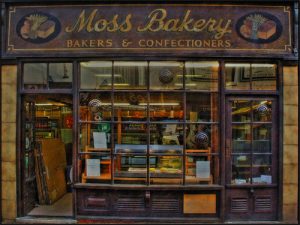You step into the store, the little bell rings above the door letting the shopkeeper know he has a new customer. Of course, he instantly recognizes you. “Hey Bob, welcome back. I remember how much you enjoyed the brioche I made last week, so I set aside some Danish braid I baked fresh this morning. It’s quite similar. I think you’ll love it.”
 And then I wake up from my dream. Because, of course, that’s not the experience most of us have anymore. For the majority of the country, we step into a big box retailer. The doors open with a cruel, efficient “whoosh.” Sure, we get a “welcome to…” greeting, but then a cold metal shopping cart or the latest circular is thrust upon us. One-to-one marketing is dead…well, in the bricks and mortar world.
And then I wake up from my dream. Because, of course, that’s not the experience most of us have anymore. For the majority of the country, we step into a big box retailer. The doors open with a cruel, efficient “whoosh.” Sure, we get a “welcome to…” greeting, but then a cold metal shopping cart or the latest circular is thrust upon us. One-to-one marketing is dead…well, in the bricks and mortar world.
Online, it is actually alive and well, thanks to…
Customer Segmentation Analysis
Customizing offers based on customer segments involves a sequence of steps, beginning with identification of meaningful customer segments (which is the objective of the customer segmentation analysis).
Any method of customer-specific message optimization requires knowing “who” your customers are, beyond just their names and email addresses. You must also have some insight into what they “want,” how they think, the words, terms and images that attract and inspire them (as well as those that repel them), and “how” they think.
Discovering these things about all of the distinct groups of your “ideal customers” is the objective of a customer segmentation analysis.
The outcome of the customer segmentation analysis is a set of reports, charts, tables and interpretive text that strive to reveal the important characteristics that distinguish your best and most valuable customers and customer prospects, and to provide actionable recommendations about how best to communicate with them in a way that will serve them and profit your company.
Dynamic Offer-Content Customization
Once we have identified the optimal customer segments, the next step is to develop and test content at each stage in the conversion path designed to communicate your value proposition in a way that optimally conveys the elements that are most compelling to that particular segment according to their motivations, biases and thought sequence.
This is the transition point in implementing Dynamic Offer-Content Customization.
Thereafter, additional gains are achieved through the iterative optimization process that continually seeks to communicate more clearly and effectively with each customer and customer prospect to assure optimal long-term value and customer goodwill.
It should be noted that Dynamic Offer-Content Customization is only one among a host of breakthrough marketing approaches that advanced customer segmentation analysis makes possible – surely it’s far from the easiest or the least expensive.
Still, the electronic experience is the closest virtual representation of our quaint bakery shop antecedent – one-to-one marketing to your customers in a mass specialization world.
Related Resources
Optimize your Email in Three Steps: How one marketer tripled revenue from their house list
What else can I test… to increase email clickthrough rate?




We’ve been doing this since 2000. Showing different content depending on what we know about the visitor – extreme personalisation.
Our current thinking is just to get on and try things instead of getting stuck on over-analysis.